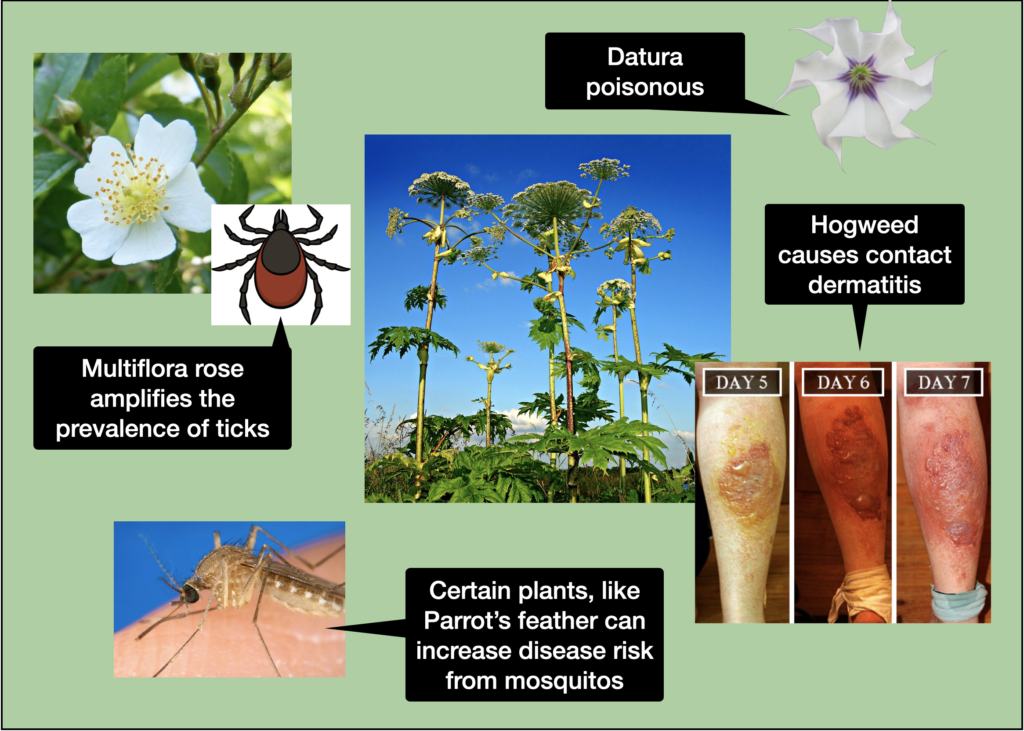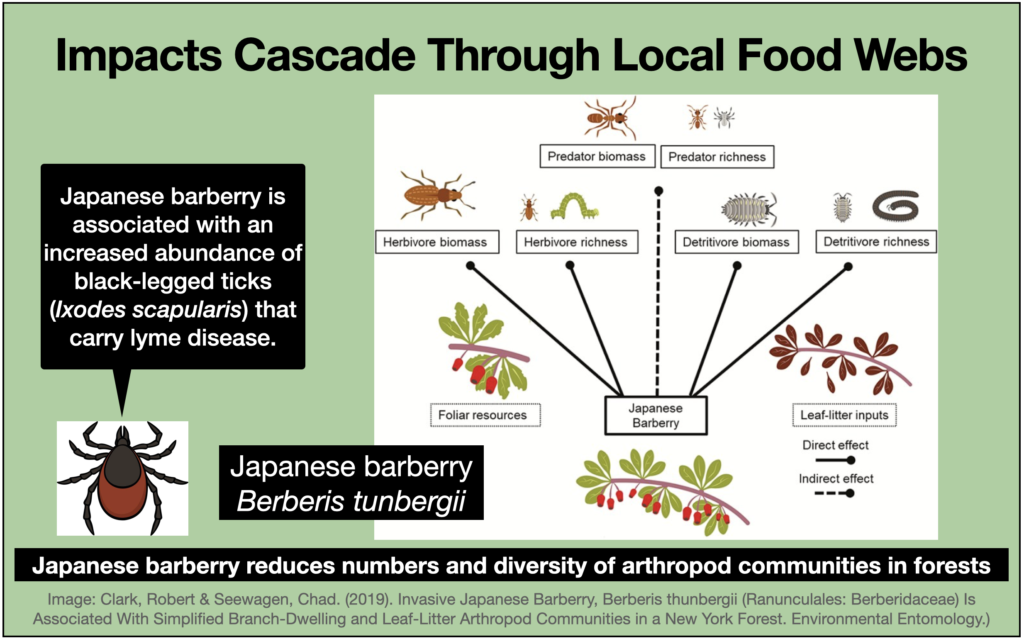Ornamental Invasive Alien Plant Species (IAS) are falling through regulatory gaps.
Because risks will only increase over time, we need to act now. Let’s look at some of the negative impacts we are trying to avoid:
- Invasive plants can increase the spread and risk of diseases and cause harm to people. For example, Japanese barberry (Berberis thunbergii) has been shown to harbour ticks and white-footed mice, significantly increasing the risk of Lyme disease. In one study, ticks carrying Lyme disease were twelve times higher in forests invaded by Japanese barberry compared to forests not invaded by barberry, (Connecticut Agricultural Experiment Station, e.g. Linske et al., 2018). Dense stands of Parrot’s feather (Myriophyllus aquaticum) have been shown to provide excellent habitat for mosquito larvae; mosquitoes can spread West Nile and Zika viruses, (Turnipseed, 2017). Plants like Giant hogweed (Heracleum mantegazzianum) can cause burns on the skin. All Datura plants contain a number of alkaloids, especially in the seeds and flowers, that are toxic, narcotic and hallucinogenic. Invasive Jimson weed (Datura stramonium) is a Primary Noxious, Class 2 weed in Canada.

- Invasive plants can be vectors for plant diseases and pests. Common buckthorn (Rhamnus cathartica) carries oak rust, a fungus that causes leaf and crown rust and affects the yield and quality of oats. Tree of heaven (Ailanthus altissima) is a host for the Brown marmorated stink bug (Halyomorpha halys) and spotted lanternfly (Lycorma delicatula), (Leskey et al. 2017; Murman et al. 2020). This disease and these pests threaten agriculture.
- Invasive plants can cause extirpation or extinction of native species. All monarch butterflies, a Species At Risk, will lay eggs on dog strangling vines (Vincetoxicum species). All larvae that feed on these vines will die, (Casagrande, 2007). Invasive plant species, like Multiflora Rose (Rosa multiflora) and Japanese Barberry (Berberis thunbergii), threaten Species at Risk, like American Ginseng (Panax quinquefolius), (Environment Canada, 2015).
- Invasive plants like Bohemian, Giant, Himalayan and Japanese knotweeds (species in the family Polygonaceae) can out-compete other plants and change habitat structure. “Reynoutria invasion are characterized by shifts from a plant-based to a detritus-based food chain,” (Kappes, 2007). The presence of knotweed may disrupt “functional linkages within the soil food web, which may ultimately modify ecosystem stability and functioning,” (Brousseau, 2021). These knotweeds, introduced as horticultural plants, can also harm buildings and homes, negatively impacting property values. For further information, see Invasive Species Council Risk Assessments (Invasive Species Council Risk Assessments).
- Invasive plants may alter the local food webs. For example, invasive Japanese barberry (Berberis thunbergii) reduces the number and diversity of arthropod communities in forests where it has spread, (Clark & Chad; 2019).

- Invasive plants may alter water movement and quality. Monocultures of ornamental salt cedars (Tamarix spp.) reduce water tables, displace native riparian trees, reduce plant and animal diversity, alter bank structure and geomorphological processes, (USFWS, 2019).
- Invasive plants can hybridize with related species or varieties and may degrade native gene pools and drive species to extinction. One example of this is the introduced white mulberry (Morus alba), a native to central and eastern China that hybridizes with the Ontario native red mulberry (Morus rubra), which is currently listed as endangered, (COSEWIC Assessment, 2004).
- Invasive plants can alter energy and nutrient flows. Introduced honeysuckle (Lonicera maackii) for example, impacts water and nutrient transformation, (McNeish & McEwan, 2016). Russian olive (Elaeagnus angustifolia) can substantially increase terrestrial organic matter and decrease ecosystem respiration in streams, (Mineau et al. 2014). These alteration can change plant communities and soil properties. Soils may be more susceptible to erosion. Water quality in area streams, rivers and lakes can be diminished.
- Invasive plants may harm aquatic ecosystems in other ways. For example, European frogbit (Hydrocharis morsus-ranae) can deplete water oxygen, which can be stressful or fatal for fish and other aquatic organisms. (Simkovic, 2020).
- Invasive plants may alter the composition and function of habitats and ecosystems. The presence of Norway maple (Acer platanoides), for example, changes ecosystems and modifies forest communities. Native trees, shrubs and woodland plants are not able to live under the dry and shady conditions created by Norway maples. This in turn may increase soil erosion risks, leaving the roots of existing native trees exposed and causing further harm, (Fang & Wang, 2020; Simkovic, 2020).
- Cascading impacts can occur with the spread of invasive species. They can disrupt habitats and invite other invasive plants, pests and or diseases. A good example of this is buckthorn (Rhamnus cathartica and Frangula alnus). Introduced as a landscape plants centuries ago, Buckthorn is a host for oat rust, a host for soybean aphid and it transforms habitats, (Kehoe et al., 2020; Heimpel et al., 2010).

- Damaging invasive species outcompete natives, unbalance local ecosystems, and threaten to homogenize the world’s ecological assemblages. We risk losing our precious botanical heritage and with that, our identity and sense of place. This loss can be particularly significant for native peoples, especially when culturally important species are affected, (Invasive Species Council of BC, 2019).

Join us in calling for improved regulations!
